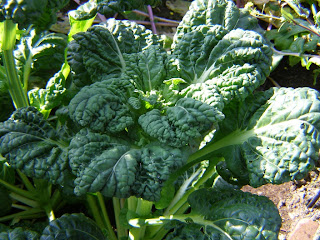RHS Garden Rosemoor, in
an out-of-the-way corner of Devon, is the most modest of the four RHS
gardens, rarely shouting about its look-at-me attractions, preferring
just to let people come and find out for themselves.
But oh, do make the
effort: it's a little gem. Winter gardens with forests of brilliant
scarlet cornus and dazzling Betula utilis var jacquemontii,
trunks scrubbed to a whiteness that glows; sheets of purple crocuses;
craggy oaks and the intoxicating scent of Christmas box and witch
hazels floating on the early spring air.
I was entirely
distracted, though, by their exceptionally fine fruit and vegetable garden.
One day I too will train my redcurrants in double cordons and grow
sprouts as big as golfballs. And in particular, my eye was caught by one little
glasshouse, packed with quite the finest selection of oriental greens
I've ever seen in one place.
 |
| Mustard 'Golden Streaks' |
This was a revelation. We're used to oriental mizuna, mibuna and mustard spicing up our salads in winter. But they're also excellent as mature leafy greens, a vegetable in their own right, cooked lightly – a little like spinach – or stir-fried, or used in soups. The flavour takes a little getting used to, as it's spicier than our tastebuds usually allow (with a few exceptions).
They're strikingly
good-looking – I hadn't appreciated quite how handsome until I saw
them en masse at Rosemoor. And being cool-weather plants, you can
grow them through winter, releasing you from endless cabbages with a
fresh, crisp flavour that sings on your tongue.
With some, you just eat
the leaves; others yield crisp, water-filled stems or flowerbuds.
Some, all three, so you can pick them at three different stages of
growth. The varieties I spotted at Rosemoor were:
Red Komatsuna
(Mustard Spinach): big, beefy red-tinged leaves. They had the
green version too. Sue Stickland says this has a mild taste, 'like a
slightly peppery cabbage'.
Mustard 'Golden
Streaks': like curly endive with deeply-cut, almost frizzy
leaves. Often described as having a 'sweet mustard flavour' –
whatever that means. A testing panel from the RHS found it had a
'powerful peppery flavour' but also said it was piquant, earthy and
sweet.
 |
| Shungiku |
Mustard
'Green-in-Snow': brilliant green, serrated-edged leaves; and
Mustard 'Red Giant': the only one I've grown, a familiar
ingredient in salads with its reddish bronze tinted leaves. Both are
getting towards the hotter end of the scale. According to Sue
Stickland, 'if you like watercress, you'll love this'.
Mustard 'Osaka
Purple': leaves so big they look like a loose cabbage: the purple
is in the veining. The leaves are very hot and spicy in the raw –
but once cooked they lose much of their bite and become
richly-flavoured but mild.
 |
| Tatsoi 'Yukina Savoy' |
Cooking: recipes are – cautiously - finding their way into cookbooks. Pick the growth tips and dip in batter before deep-frying for tempura, or wilt large leaves in a tiny bit of water like spinach. Stir-fry in oil with spring onions, ginger and garlic; and cut thick stems into 10cm pieces, blanch in fast-boiling water for a minute or two, then stir-fry with a little sugar, ginger, rice wine vinegar and oyster sauce.
Joy Larkcom brought Asian greens to the UK and has written an excellent book on the subject (recently updated). But we all seem to have stopped at the baby-leaf stage. Oriental greens have so much more to offer: this year, I'm going to let them grow up.








1 comment:
I'm growing a lot of these for the first time on my balcony as part of the salad challenge. They provide some good shapes and structure too, which is useful.
Post a Comment